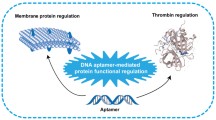Abstract
A peptide aptamer that changes fluorescence upon binding to verotoxin was selected in vitro using ribosome display with a tRNA carrying an environment-sensitive fluorescent probe. The aptamer specifically bound to verotoxin with a dissociation constant (K d) of 3.94 ± 1.6 µM, and the fluorescence decreased by 78 % as the verotoxin concentration was increased. The selected peptide can be used for detection of verotoxin.





Similar content being viewed by others
References
Borrebaeck CAK (2000) Antibodies in diagnostics—from immunoassays to protein chips. Immunol Today 21:379–382
Gilardi G, Zhou LIQ, Hibbert L, Cass AEG (1994) Engineering the maltose binding protein for reagentless fluorescence sensing. Anal Chem 66:3840–3847
Ito Y, Tada S (2013) Bio-orthogonal and combinatorial approaches for design of binding growth factors. Biomaterials 34:7565–7574
Jespers L, Bonnert TP, Winter G (2004) Selection of optical biosensors from chemisynthetic antibody libraries. Protein Eng Design Sel 17:709–713
Jhaveri S, Rajendran M, Ellington AD (2000) In vitro selection of signaling aptamers. Nat Biotechnol 18:1293–1297
Keusch JJ, Manzella SM, Nyame KA, Cummings RD, Baenziger JU (2000) Cloning of GB3 synthase, the key enzyme in globo-series glycosphingolipid synthesis, predicts a family of α1,4-glycosyltransferases conserved in plants, insects and mammals. J Biol Chem 275:25315–25321
Li S, Millward S, Roberts R (2002) In vitro selection of mRNA display libraries containing an unnatural amino acid. J Am Chem Soc 124:9972–9973
Li Z, Uzawa T, Tanaka T, Hida A, Ishibashi K, Kataura H, Kobatake E, Ito Y (2013) In vitro selection of peptide aptamers with affinity to single-wall carbon nanotubes using a ribosome display. Biotechnol Lett 35:39–45
Li Z, Uzawa T, Zhao H, Luo SC, Yu H, Kobatake E, Ito Y (2014) In vitro selection of peptide aptamers using a ribosome display for a conducting polymer. J Biosci Bioeng 117:501–503
Liu M, Tada S, Ito M, Abe H, Ito Y (2012) In vitro selection of a photo-responsive peptide aptamer by ribosome display. Chem Commun 48:11871–11873
Muranaka N, Hohsaka T, Sisido M (2006) Four-base codon mediated mRNA display to construct peptide libraries that contain multiple nonnatural amino acids. Nucleic Acids Res 34:1–9
Nutiu R, Li Y (2003) Structure-switching signaling aptamers. J Am Chem Soc 125:4771–4778
Paige JS, Duc NT, Song W, Jaffrey SR (2012) Fluorescence imaging of cellular metabolites with RNA. Science 335:1194–1196
Tada S, Timucin E, Kitajima T, Sezerman OU, Ito Y (2014) Direct in vitro selection of titanium-binding epidermal growth factor. Biomaterials 35:3497–3503
Uzawa T, Tada S, Wang W, Ito Y (2013) Expansion of aptamer library from “natural soup” to “unnatural soup”. Chem Commun 49:1786–1795
Wang W, Hara S, Liu M, Aigaki T, Shimizu S, Ito Y (2011) Polypeptide aptamer selection using a stabilized ribosome display. J Biosci Bioeng 112:515–517
Wang W, Uzawa T, Tochio N, Hamatsu J, Hirano Y, Tada S, Saneyoshi H, Kigawa T, Hayashi N, Ito Y, Taiji M, Aigaki T, Ito Y (2014) A fluorogenic peptide probe developed by in vitro selection using tRNA carrying a fluorogenic amino acid. Chem Commun 50:2962–2964
Yamada Y, Miura Y, Sakaki A, Yoshida T, Kobayashi K (2006) Design of multifunctional peptides expressing both antimicrobial activity and shiga toxin neutralization activity. Bioorg Med Chem 14:77–82
Yamazaki M, Sato S, Gondaira F, Sugiyama J (2001) A rapid bioluminescent enzyme immunoassay (BLEIA) for the detection of Shiga Toxin types 1 and 2. Microbiol Immunol 45:621–628
Yang CJ, Jockusch S, Vicens M, Turro NJ, Tan W (2005) Light-switching excimer probes for rapid protein monitoring in complex biological fluids. Proc Natl Acad Sci USA 102:17278–17283
Acknowledgments
The research is financially supported by a Grant-in-Aid for Scientific Research (S) of KAKENHI 22220009 from the Japan Society for the Promotion of Science “and The Cannon Foundation”. We are grateful for the support received from the Brain Science Institute (BSI) Research Resource Center for sequencing, HPLC purification and mass spectrum analysis.
Author information
Authors and Affiliations
Corresponding author
Rights and permissions
About this article
Cite this article
Manandhar, Y., Bahadur, K.C.T., Wang, W. et al. In vitro selection of a peptide aptamer that changes fluorescence in response to verotoxin. Biotechnol Lett 37, 619–625 (2015). https://doi.org/10.1007/s10529-014-1719-7
Received:
Accepted:
Published:
Issue Date:
DOI: https://doi.org/10.1007/s10529-014-1719-7




